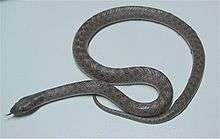Hypsiglena torquata jani
| Hypsiglena torquata jani | |
|---|---|
 | |
| Scientific classification | |
| Kingdom: | Animalia |
| Phylum: | Chordata |
| Subphylum: | Vertebrata |
| Class: | Reptilia |
| Order: | Squamata |
| Suborder: | Serpentes |
| Family: | Colubridae |
| Subfamily: | Dipsadinae |
| Genus: | Hypsiglena |
| Species: | H. torquata |
| Subspecies: | H. t. jani |
| Trinomial name | |
| Hypsiglena torquata jani (Dugès, 1866) | |
 | |
| The distribution of Hypsiglena torquata jani (brown), which now includes the two former subspecies Hypsiglena torquata dunklei (orange), and Hypsiglena torquata texana (yellow). | |
| Synonyms | |
| |
Hypsiglena torquata jani, commonly known as the Texas night snake, is a subspecies of small colubrid native to the southwestern United States and northeastern Mexico.
Etymology
The epithet, jani, is in honor of Italian taxonomist Giorgio Jan.[7]
Description
The Texas night snake grows from 10 to 16 inches (25 to 41 centimetres) in total length, record 20 inches (51 cm).[8] It is typically a light gray or tan in color, with dark brown or dark gray blotching down the back and an unmarked underside. They have smooth dorsal scales, eyes with vertically elliptical pupils, are rear-fanged, and are considered to be venomous, though they are not dangerous to humans.
Behavior
As their common name implies, they are a primarily nocturnal snake.
Diet
Their diet consists of primarily lizards, but they will also eat smaller snakes and occasionally soft bodied insects.
Habitat
They prefer semi-arid habitats with rocky soils.
Reproduction
They are an oviparous species that breeds in the spring rainy season, laying 4-6 eggs that take approximately 8 weeks to incubate before hatching. The eggs average 27 mm (1.1 in) long by 10 mm (3⁄8 in) wide. The hatchlings are about 15 cm (5.9 in) in total length.[5]
Geographic range
The Texas night snake ranges from southern Kansas to southern Colorado, and south throughout New Mexico, the western half of Texas to central Mexico.
References
- 1 2 The Reptile Database. www.reptile-database.org.
- ↑ Stejneger, L., and T. Barbour. 1917. A Check List of North American Amphibians and Reptiles. Harvard University Press. Cambridge, Massachusetts. 125 pp. (Hypsiglena ochrorhynchus texana, p. 93.)
- ↑ Taylor, E.H. 1938. On Mexican Snakes of the Genera Trimorphodon and Hypsiglena. Univ. Kansas Sci. Bull. 25 (16): 357-383. ("Hypsiglena torquata dunklei subsp. nov.", pp. 374-375 + Plate XXXVII, figure 1.)
- ↑ Global Names Index. gni.globalnames.org.
- 1 2 Wright, A.H., and A.A. Wright. 1957. Handbook of Snakes of the United States and Canada. Comstock. Ithaca and London. 1,105 pp. (in 2 volumes) (Hypsiglena torquata texana, pp. 326-330, Figure 101. + Map 30. on p. 315.)
- ↑ Mulcahy, D.G. 2007. Molecular systematics of neotropical cat-eyed snakes: a test of the monophyly of Leptodeirini (Colubridae: Dipsadinae) with implications for character evolution and biogeography. Biol. Journ. Linnaean Society 92: 483-500. (Hypsiglena jani)
- ↑ Beolens, B.; Watkins, M.; Grayson, M. 2011. The Eponym Dictionary of Reptiles. Johns Hopkins University Press. Baltimore, Maryland. xiii + 296 pp. ISBN 978-1-4214-0135-5. (Hypsiglena jani, p. 133.)
- ↑ Conant, R. 1975. A Field Guide to Reptiles and Amphibians of Eastern and Central North America, Second Edition. Houghton Mifflin. Boston. 429 pp. ISBN 0-395-19977-8 (paperback). (Hypsiglena torquata texana, p. 217 + Plate 33 + Map 170.)
Further reading
- Dugès, A. 1865. Du Liophis janii. Mém. Acad. Sci. Lett. Montpellier 6: 32-33.
- Tanner, W.W. 1944. A Taxonomic Study of the Genus Hypsiglena. Great Basin Naturalist 5 (3 & 4): 25-92. (Hypsiglena dunklei, p. 48; H. ochrorhynchus janii, pp. 48–51; and H. o. texana, pp. 51–54.)
External links
- Species Hypsiglena torquata at The Reptile Database